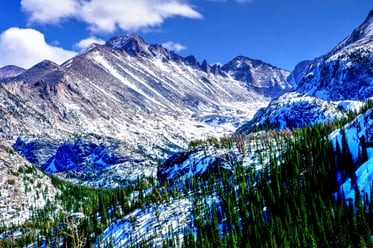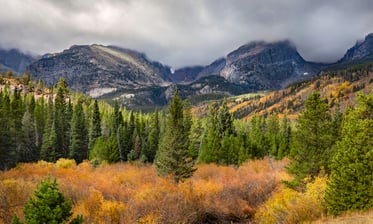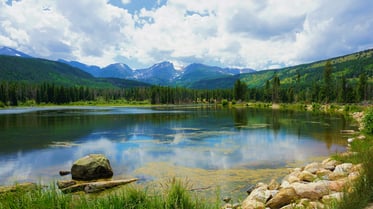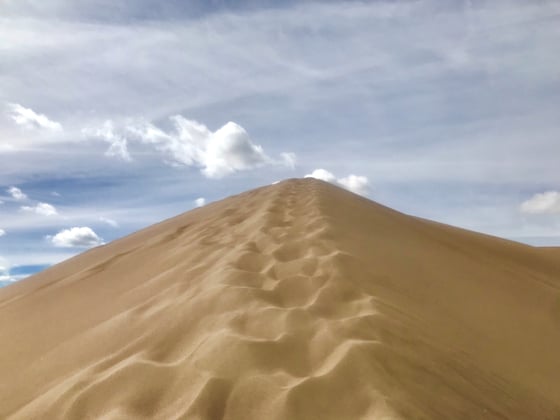Colorado Camping Destination Guide
This essential guide will help you prepare for an unforgettable journey through the Colorado Rockies.



Essential Travel Information for Camping in Colorado
Everything you need to know before your Colorado Rockies adventure
Transportation
- Public Transit: Limited between mountain towns. The CDOT Bustang connects major destinations.
- Airport: Denver International Airport (DEN) is the main gateway to the Rockies.
- Need help searching for a flight? We recommend Skyscanner.com to compare different routes and rates. Click here to search!
Costs & Payments
- ATMs: Available in towns, but may be limited in remote areas.
- Credit Cards: Widely accepted, but carry some cash for small establishments.
Mobile & Internet
- Cell Coverage: Spotty in remote mountain areas. Verizon typically has the best coverage in the Rockies.
- WiFi: Available at most lodging and in town centers, but don't count on it when hiking.
- Offline Maps: Download offline maps before heading into remote areas.
- Emergency Device: Consider a satellite communicator for backcountry activities.
Time Zone
- Colorado follows Mountain Time (MT).
- Mountain Time is UTC-7 during Standard Time and UTC-6 during Daylight Saving Time.
- Daylight Saving: Observed from March to November.
Climate & Weather
- Mountain Weather: Can change rapidly. Plan for temperature swings of 30°F+ in a single day.
- Summer: 70-80°F (21-27°C) during the day, 40-50°F (4-10°C) at night.
- Winter: 20-35°F (-7 to 2°C) during the day, below freezing at night.
- Afternoon Thunderstorms: Common in summer - start hikes early in the morning.
Emergency Contacts
- Emergency: 📞 911
- Colorado State Patrol: 📞 *CSP (*277) from mobile phones
- Rocky Mountain National Park Emergency: 📞 970-586-1203
- Poison Control: 📞 1-800-222-1222
- Search & Rescue: Dial 911 (No charge for mountain rescues in Colorado)
Packing Checklist for Camping in Colorado
Use this checklist to ensure you're prepared for Colorado's mountains and changing weather
Hiking & Outdoor Essentials
- Sturdy hiking boots (broken in before your trip)
- Day pack (20-30 liters) with rain cover
- Reusable water bottles or hydration system (2-3 liter capacity)
- Trekking poles
- Headlamp or flashlight with extra batteries
- Navigation tools (maps, compass, GPS device)
- First aid kit with blister treatment
- Sunglasses with UV protection
- Sunscreen (SPF 50+) and lip balm with SPF
- Insect repellent
Clothing & Layering
- Moisture-wicking base layers
- Quick-dry hiking pants and shorts
- Long and short-sleeve shirts (synthetic or wool)
- Mid-layer insulation (fleece or lightweight puffy)
- Waterproof/windproof outer layer (rain jacket and pants)
- Warm jacket (even in summer for high elevations)
- Hiking socks (wool or synthetic blend) with spares
- Hat with brim for sun protection
- Warm beanie and gloves
- Swimwear (for hot springs or alpine lakes)
Health & Safety
- Prescription medications (extra supply)
- Pain relievers and anti-inflammatory drugs
- Altitude sickness medication (consult your doctor)
- Electrolyte packets or tablets
- Water purification method (filter, tablets, or SteriPEN)
- Hand sanitizer and wet wipes
- Personal toiletries
- Travel insurance details
- Emergency contacts and medical information card
- COVID-19 supplies (masks, test kits, as needed)
Additional Items
- Camera and spare batteries/charger
- Binoculars for wildlife viewing
- Hiking snacks and emergency food
- Dry bags or waterproof cases for electronics
- Small daypack for short hikes
- Camping gear (if applicable)
- National Parks Pass
- Field guides for local wildlife and plants
- Journal and pen
- Portable charger/power bank
Mountain Tips
- Always layer clothing as temperatures can vary widely throughout the day at higher elevations.
- Pack assuming weather will be unpredictable - mountain storms can develop quickly.
- Drink more water than you think you need - altitude causes faster dehydration.
- Protect yourself from the intense mountain sun, even on cloudy days.
Camping Information
Important details about your participatory camping experience in the Colorado Rockies
Participatory Camping
This is a participatory camping trip, where all travelers will assist in setting up camp and cooking meals. Guides will teach you the best methods for quick set up and take down of tents and will lead the cooking, providing clear instructions and oversight.
If you've never set up camp or cooked outdoors before, this is the perfect opportunity to learn under expert supervision!
Camping Equipment Details:
- Tents: 4-person camping tents, double occupancy. You'll use camping pads on the ground beneath your sleeping bags.
- What's Provided: All camping gear except for sleeping bags and pillows will be provided.
- Guide Equipment: Our Guides carry company-issued first aid kits, satellite phones (for emergencies only) and epinephrine kits (for allergic reactions).
About the Food:
- We provide a diversity of foods containing the necessary nutrition for sustained energy output.
- Meals are made from staples that travel well in the backcountry - rice, pasta, lentils, beans, couscous, oatmeal, granola, etc.
- Meals are also supplemented with trail foods such as crackers, cheese, granola, energy bars, fresh and/or dried fruit, and energy drink mixes.
- We regularly accommodate vegan, vegetarian, kosher, and non-gluten diets and will make adjustments for food allergies.
- In addition to your personal belongings, you will be responsible for carrying a portion of the food.
- Important note: It's critical that you include your dietary needs in your traveler form - it's too late once you've arrived!
Campground Facilities
- Toilets: Private campgrounds offer flushing toilets and hot showers, some even offer laundry rooms and small stores for supplies. Remote or rustic campgrounds might only have pit toilets, but they make up for it with expansive silence and immersive natural experiences.
- Showers: Please be aware that not all campsites have shower facilities. If that is the case, your Guide will take the group to a place to shower. Please have cash or spare change on hand as you may need to purchase shower tokens.
- Water: You will have clean drinking water provided at campgrounds in the mornings and at various times during the day. Please bring a water bottle that can carry 2 liters, or a Camelbak or similar.
- Charging: There may be outlets at certain campsites in public areas, but we highly suggest bringing a fully charged power bank or two to supplement this.
- WiFi: Wifi and cell service are usually non-existent or very limited at the campgrounds. Some campgrounds may offer free wifi, although it may be unreliable.
- Security: The van will be towing a small cargo carrier, which will be locked during the day and while in transit. You'll be able to store your luggage and valuables here.
Special Requests:
- Cots: In general, the tents our partners use cannot accommodate a cot. If you have a genuine medical need, please get in touch and we will endeavor to find a solution.
- Guide Rest Time: Guides are required to take 8 hours of each 24-hour period to sleep, recuperate, take personal/downtime/ etc. In addition, as part of the 8 hours off they must sleep/rest or be in their tents uninterrupted for a minimum of 5 hours each night. We ask guests to respect these requirements and not interrupt Guides' time off and sleep time unless there is a true (life-threatening) emergency.
Sandboarding Activity
Prepare for an exciting sandboarding adventure in the Colorado dunes

What to Know About Sandboarding
Experience the thrill of sliding down magnificent sand dunes on specially designed sandboards!
Equipment & Attire:
- Provided Equipment: Sandboards are the only piece of equipment that's provided in the sandboard rental.
- Recommended Clothing: Loose-fitting, comfortable clothing is recommended; long sleeves and long pants made with breathable material are also recommended to protect from UV rays and sand.
- Accessories: Sunglasses can also protect against UV rays and sand, along with sunscreen of course!
- Footwear: Closed-toe sneakers are recommended for comfort and protection.
Training & Preparation
Follow these training recommendations to prepare for your Colorado Rockies adventure
Training Schedule
If you have access to hiking trails and a schedule to accommodate it, begin walking and hiking in hilly/steep terrain. Try to get out at least 3 days a week. Start with short hikes (1-hour in length) with a light daypack.
From week to week build the length and difficulty of your hikes and gradually increase your pack weight until you're comfortably able to hike 6-8 hours a day carrying the weight you'll have on your trip. It is ideal to begin your training at least 12 weeks prior to your trip. Also, be sure to use the boots you'll have on your trip to break them in.
Sample Training Program:
First week of training
- Tuesday: one-hour hike with a daypack
- Thursday: one-hour hike with a daypack
- Sunday: 2-hour hike with a daypack
Two weeks before the trip
- Monday: 3.5-hour hike with a 20-pound pack
- Wednesday: 2-hour hike with a 20-pound daypack
- Thursday: 3.5-hour hike with a 20-pound pack
- Sunday: 7-hour hike with the weight you'll have on your trip
Supplemental Training Ideas
There are many other activities that are easily incorporated into your daily life to build your overall fitness. Cross-training is also important to strengthen opposing muscle groups and it helps to avoid over-use injuries.
- Stair Climbing: Climb the stairs at your office, house, park, or neighborhood with a backpack. Stair climbing is a fantastic way to simulate backpacking in hilly or steep terrain.
- Cycling: Bike to work or when running errands. Bike around town or on country roads outside of your town/city. Cycling is a great way to build endurance and strength in your legs.
- Gym Activities: Include step aerobics, treadmill, bicycling, or elliptical trainers to name a few. A modest weight training program focusing on the muscles that support the ankles, knees, back, and shoulders is also beneficial.
- Swimming: A great way to build endurance and cardiovascular fitness and is easy on the joints.
- Daily Activities: Walk to work instead of driving. Run your errands by walking and carrying your groceries home in a backpack.
- Flexibility & Strength: Yoga and/or Pilates classes can build strength throughout your body while also improving your flexibility.
- Sports: Intramural sports.
- Jogging: Another option, however, if you are not a regular runner it can easily lead to injuries that backpacking may then exacerbate. Undertake a jogging routine with care.
Top Destinations & Experiences
Discover the incredible places to visit during your Colorado Rockies adventure

Rocky Mountain National Park
Experience the crown jewel of Colorado's parks with over 300 miles of hiking trails and breathtaking alpine scenery.
Must-See Attractions:
- Trail Ridge Road – America's highest continuous paved road with panoramic vistas.
- Bear Lake – Easy access to stunning alpine lakes and mountain views.
- Emerald Lake Trail – A moderate hike to one of the park's most photographed lakes.
- Wildlife Viewing – Spot elk, moose, bighorn sheep, and marmots throughout the park.
Colorado Mountain Cuisine
Colorado offers delicious local specialties influenced by Western traditions, modern farm-to-table principles, and mountain culture. Don't miss these iconic local dishes and drinks:
Bison Steak
Lean, flavorful meat from America's iconic plains animal.
Craft Beer
Colorado is a craft brewing capital with over 400 breweries.
Green Chile
Southwestern stew made with roasted Pueblo or Hatch chiles.
Elk Medallions
Tender, rich game meat popular in mountain restaurants.
Colorado Honey
Local wildflower and high-altitude honey with unique flavor profiles.
Rocky Mountain Oysters
A Colorado novelty: deep-fried bull testicles for the adventurous eater.
Mountain Safety & Responsible Travel
Tips for staying safe and minimizing your impact on Colorado's fragile mountain environments
Mountain Safety
- Altitude Sickness: Acclimate gradually by staying hydrated, avoiding alcohol, and ascending slowly. Symptoms include headache, nausea, fatigue, and dizziness.
- Lightning Safety: Afternoon thunderstorms are common. Get below treeline by noon and avoid exposed ridges during storms.
- Wildlife Awareness: Keep a safe distance from all wildlife. Never approach or feed animals.
- Trail Safety: Always tell someone your hiking plans. Carry the 10 essentials: navigation, headlamp, sun protection, first aid, knife, fire starter, shelter, food, water, and extra clothes.
- Water Crossings: Use extreme caution with stream crossings during spring runoff (May-June).
Leave No Trace
- Plan Ahead: Know regulations, prepare for extreme weather, and schedule to avoid crowded times.
- Stay on Trail: Travel on durable surfaces and established trails to protect fragile alpine vegetation.
- Pack It Out: Pack out all trash, leftover food, and litter.
- Leave What You Find: Preserve the past by leaving rocks, plants, and artifacts as found.
- Minimize Campfire Impact: Use established fire rings or stoves for cooking. Check local fire restrictions.
- Respect Wildlife: Observe from a distance and never feed animals.
- Be Considerate: Respect other visitors and protect the quality of their experience.
⚠️ Important Altitude Note
Many Colorado mountains reach elevations above 10,000 feet where oxygen levels are significantly lower. If you experience severe altitude sickness symptoms (confusion, shortness of breath at rest, inability to walk), seek medical attention immediately and descend to lower elevation.
Tipping
Tips for guides, drivers and restaurants are not included. Tips provide supplemental income, and, while not mandatory, are greatly appreciated. If the local teams have added to the experience, please reward them.
| Guides | USD $10-15 per person/per day | |
| Drivers | USD $5-10 per person/per day |
